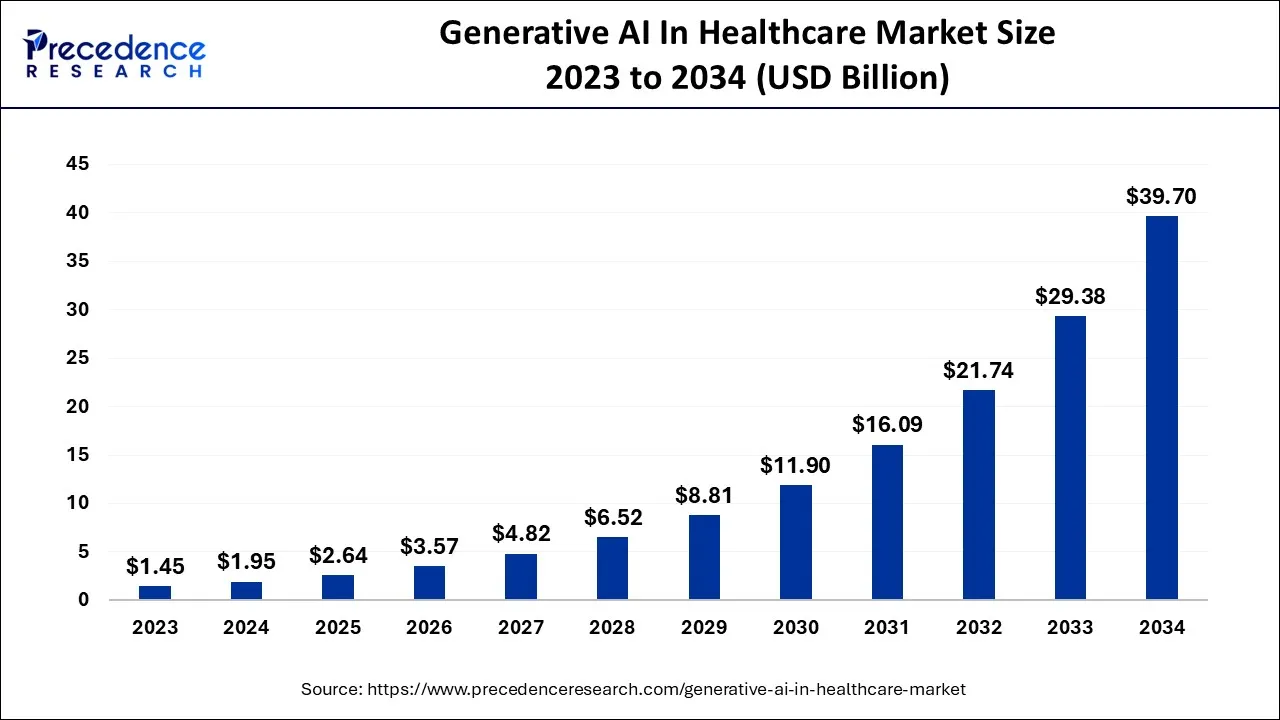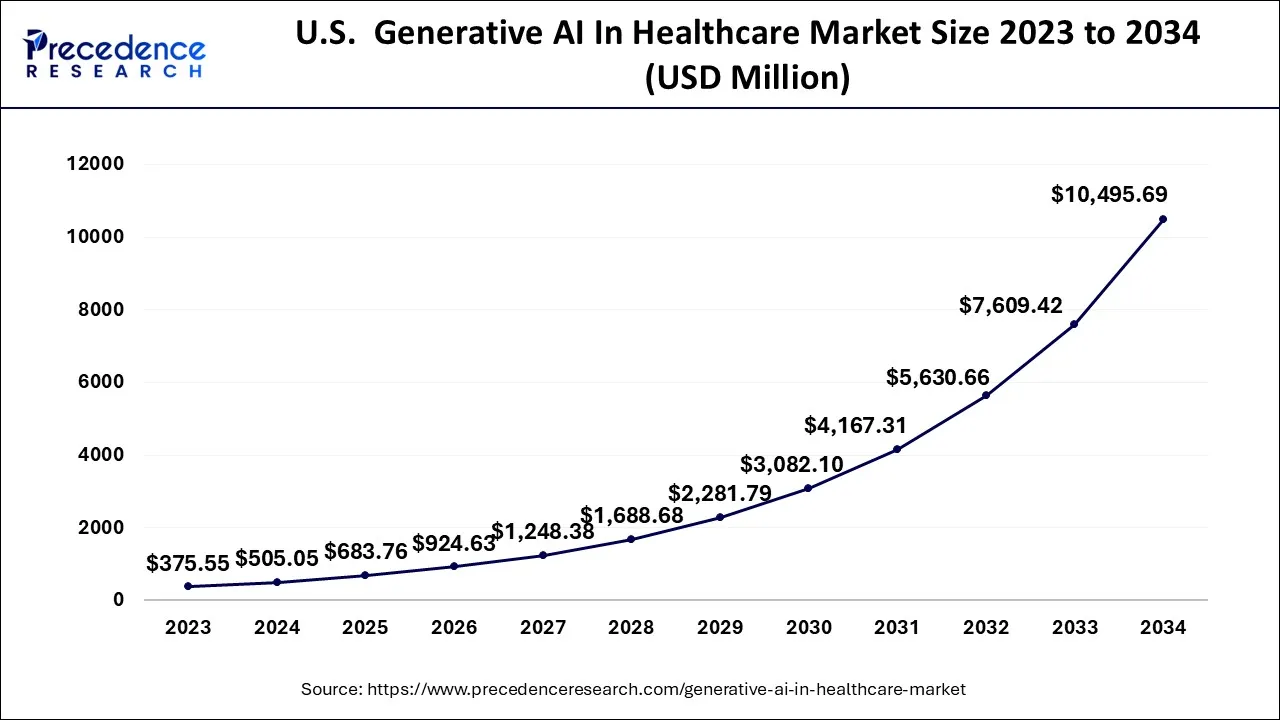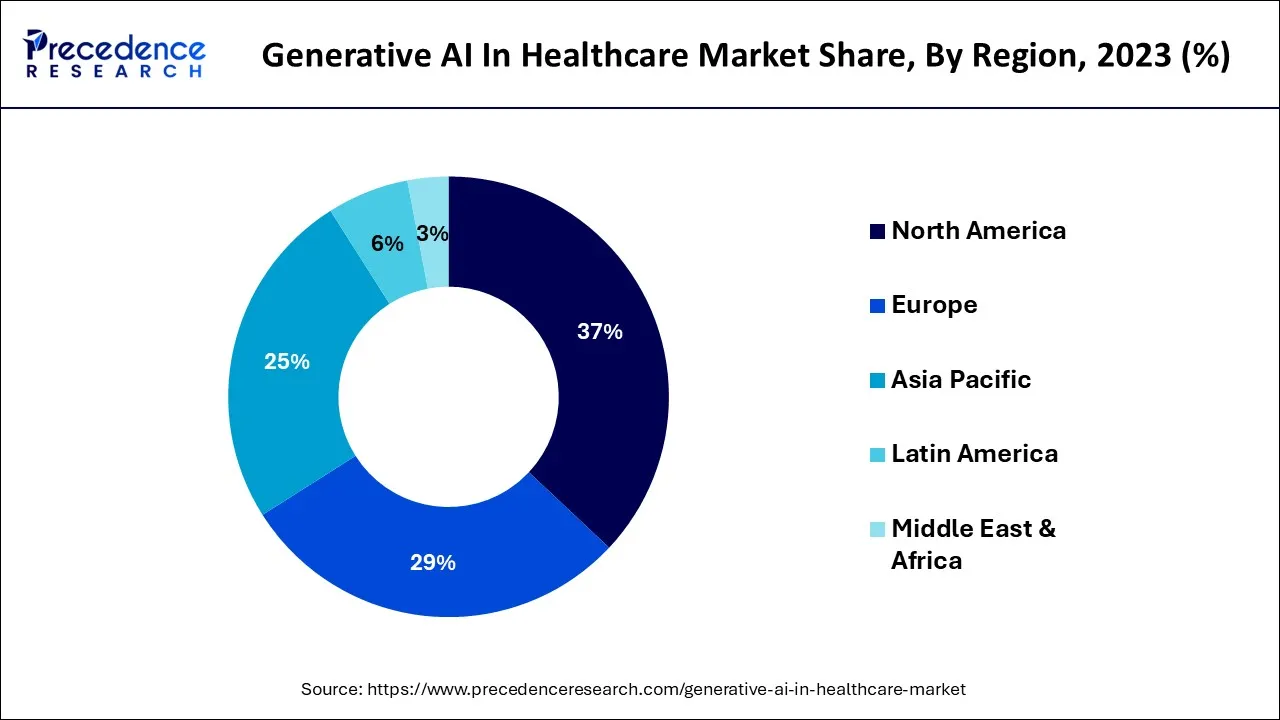October 2024
The global generative AI in healthcare market size accounted for USD 1.95 billion in 2024, grew to USD 2.64 billion in 2025 and is expected to be worth around USD 39.70 billion by 2034, registering a CAGR of 35.17% between 2024 and 2034. The North America generative AI in healthcare market size is calculated at USD 720 million in 2024 and is estimated to grow at a CAGR of 35.35% during the forecast period.
The global generative AI in healthcare market size is calculated at USD 1.95 billion in 2024 and is projected to surpass around USD 39.70 billion by 2034, growing at a CAGR of 35.17% from 2024 to 2034.

The U.S. generative AI in healthcare market size is exhibited at USD 505.05 million in 2024 and is projected to be worth around USD 10,495.69 million by 2034, growing at a CAGR of 35.45% from 2024 to 2034.

North America is expected to dominate the market during the forecast period. The growth in the region is attributed to the growing adoption of the healthcare institution. Healthcare institutions in North America, including hospitals, clinics, and diagnostic centers, are increasingly recognizing the potential of generative AI and integrating it into their workflows. Generative AI is being applied in various clinical domains, such as radiology, pathology, and cardiology, to enhance diagnostic accuracy, optimize treatment planning, and improve patient outcomes.
The adoption of generative AI in these institutions is driven by the need for advanced tools and technologies that can augment healthcare professionals' capabilities and streamline healthcare processes. For instance, according to a study from Harvard University and McKinsey & Company, increased AI use might help the United States save 5% to 10%, or $200 billion to $360 billion annually. Therefore, the growing adoption of generative AI in healthcare institutions is expected to drive market growth in the region.

Asia Pacific is expected to grow at the highest CAGR over the forecast period owing to the large and diverse patient population and increasing government initiatives. The region has a large and diverse patient population, providing a rich dataset for training generative AI models. The availability of diverse data enables the development of robust and accurate generative AI algorithms, leading to improved diagnosis, treatment planning, and patient outcomes.
Generative AI models trained on data from the Asia Pacific can account for unique regional characteristics and diseases. In addition, governments in the region are actively promoting AI adoption in healthcare and supporting research and development in the field. They provide funding, infrastructure, and regulatory frameworks to encourage the growth of generative AI in healthcare. These initiatives foster collaborations between industry, academia, and healthcare institutions, accelerating the development and adoption of generative AI solutions. Thus, this is expected to drive the regional growth.
Generative AI, a subset of artificial intelligence (AI), is making significant strides in revolutionizing the healthcare industry. By leveraging advanced machine learning algorithms, generative AI models can create new data instances that closely resemble real-world healthcare data. These innovative techniques have the potential to transform various aspects of healthcare, ranging from diagnostics and disease prediction to drug discovery and patient care. Generative AI operates on the principle of Generative Adversarial Networks (GANs), which consist of two primary components such as a generator network and a discriminator network. The generator network is trained to generate artificial data, such as medical images, patients record, or molecular structures, while the discriminator network attempts to distinguish between real and generated data. Through an iterative and competitive process, these networks improve their performance, leading to the generation of highly realistic and useful data.
The applications of generative AI in healthcare are diverse and far-reaching. It can assist in predicting diseases, identifying risk factors, and improving diagnostic accuracy by analyzing large volumes of medical records. Medical imaging can benefit from generating AI by generating artificial images that stimulate different conditions, aiding in training healthcare professionals and refining image techniques. Furthermore, it can be used for data anonymization, removing personally identifiable information while preserving statistical properties and ensuring patient privacy. The global generative AI in the healthcare market is being driven by several factors including growing collaboration among the key players, technological advancements, and growing research and development activities.
| Report Coverage | Details |
| Market Size in 2024 | USD 1.95 Billion |
| Market Size by 2034 | USD 39.70 Billion |
| Growth Rate from 2024 to 2034 | CAGR of 35.17% |
| Largest Market | North America |
| Base Year | 2023 |
| Forecast Period | 2024 to 2034 |
| Segments Covered | By Application, By Function, and By End User |
| Regions Covered | North America, Europe, Asia-Pacific, Latin America, and Middle East & Africa |
The advantages of AI in economic implications
AI use in healthcare has a major financial impact in terms of both cost reduction and revenue creation. For instance, AI-powered chatbots may provide members and patients with rapid and individualized help, cutting down on expensive ER visits and improving access to preventative care. By identifying patients who are likely to acquire chronic diseases, predictive analytics enables healthcare professionals to take early action and avoid the need for later, more expensive treatments. More than half of healthcare institutions are preparing pilot cases this year to test out ChatGPT, an AI chatbot, for learning reasons. Additionally, by seeing patterns and trends in massive datasets, AI may also help population health management, allowing healthcare companies to customize their services to the requirements of certain patients and member groups. In general, using AI in healthcare may reduce expenses, boost revenue, and enhance patient care. Thereby, this is expected to fuel the growth of the market over the forecast period.
Data quality and reliability
Generative AI models heavily rely on high-quality, diverse, and representative datasets for training. In healthcare, obtaining such datasets can be challenging due to issues like data fragmentation, bias, and lack of standardized data formats. Poor-quality or biased training data can lead to inaccurate or unreliable generative AI outputs, compromising the effectiveness and safety of applications. Thus, acting as a major restraint on market growth.
Collaborative efforts and technological advancements
The generative AI market in healthcare is driven by collaborative efforts between technology providers, healthcare institutions, and research organizations. These collaborations foster the exchange of knowledge, resources, and expertise, pushing the boundaries of generative AI applications in healthcare. Additionally, advancements in AI technologies, computational power, and data availability contribute to the growth and sophistication of generative AI solutions. Thus, this is expected to open opportunities for the growth of the market during the forecast period.
For instance, in April 2023, to increase the use of artificial intelligence in electronic health records, Microsoft Corp. and Epic Systems Corp. Through their collaboration, the businesses will combine Epic's health record software with Microsoft's Azure OpenAI Service.
Based on the application, the global generative AI in the healthcare market is segmented into clinical and system. The clinical segment is further divided into cardiovascular, dermatology, infectious disease, oncology and others. In addition, the system segment is further bifurcated into disease diagnosis, telemedicine, electronic health records, and drug interaction. The clinical segment is expected to dominate the market over the forecast period.
The growth in the segment is attributed to the use of generative AI in various domains in the healthcare industry. Generative AI is being used to enhance medical imaging in areas such as radiology and pathology. It can generate synthetic images that simulate different conditions, improve image quality, and aid in the analysis and interpretation of medical images. For example, generative AI can generate synthetic magnetic resonance imaging (MRI) or computed tomography (CT) scans to augment training data, refine imaging techniques, and assist in the detection and diagnosis of diseases.
Moreover, they are employed to improve diagnostics and disease prediction by analyzing large datasets of patient records. It can generate synthetic patient data that captures the statistical properties of real patient populations, allowing healthcare professionals to identify patterns, risk factors, and potential treatments. Thereby, driving the segment growth.
Based on the function, the global generative AI in the healthcare market is segmented into AI-assisted robotic surgery, virtual nursing assistants, aid clinical judgment/diagnosis, workflow & administrative tasks and image analysis. The image analysis segment is expected to capture a significant market share during the forecast period. Generative AI techniques are used to enhance the quality and resolution of medical images. By generating synthetic images, generative AI models can improve clarity, reduce noise, and enhance the details of medical images obtained from various modalities such as MRI, CT scans, ultrasound, and X-rays.
This aids in better visualization, accurate interpretation, and improved diagnostic capabilities. Moreover, these models are employed to reconstruct and restore medical images. This includes tasks such as denoising, deblurring, and artifact removal. By training on large datasets of both corrupted and high-quality medical images, generative AI models can learn to reconstruct images, removing unwanted noise and artifacts, and producing clearer and more accurate representations of anatomical structures. Thus, the aforementioned characteristics of generative AI in image analysis drive market growth.
Based on the end user, the global generative AI in the healthcare industry is divided into hospitals & clinics, clinical research, healthcare organizations, diagnostic centers, and others. The diagnostic centers segment is expected to dominate the market during the forecast period. Generative AI is used to assist radiologists and other healthcare professionals in the interpretation of medical images. By training on large datasets of labeled images, generative AI models can learn to detect and classify abnormalities, aiding in the diagnosis of various conditions. Thereby, propelling the market expansion.
Segments Covered in the Report
By Application
By Function
By End User
By Geography
For inquiries regarding discounts, bulk purchases, or customization requests, please contact us at sales@precedenceresearch.com
No cookie-cutter, only authentic analysis – take the 1st step to become a Precedence Research client
October 2024
October 2024
January 2025
September 2024